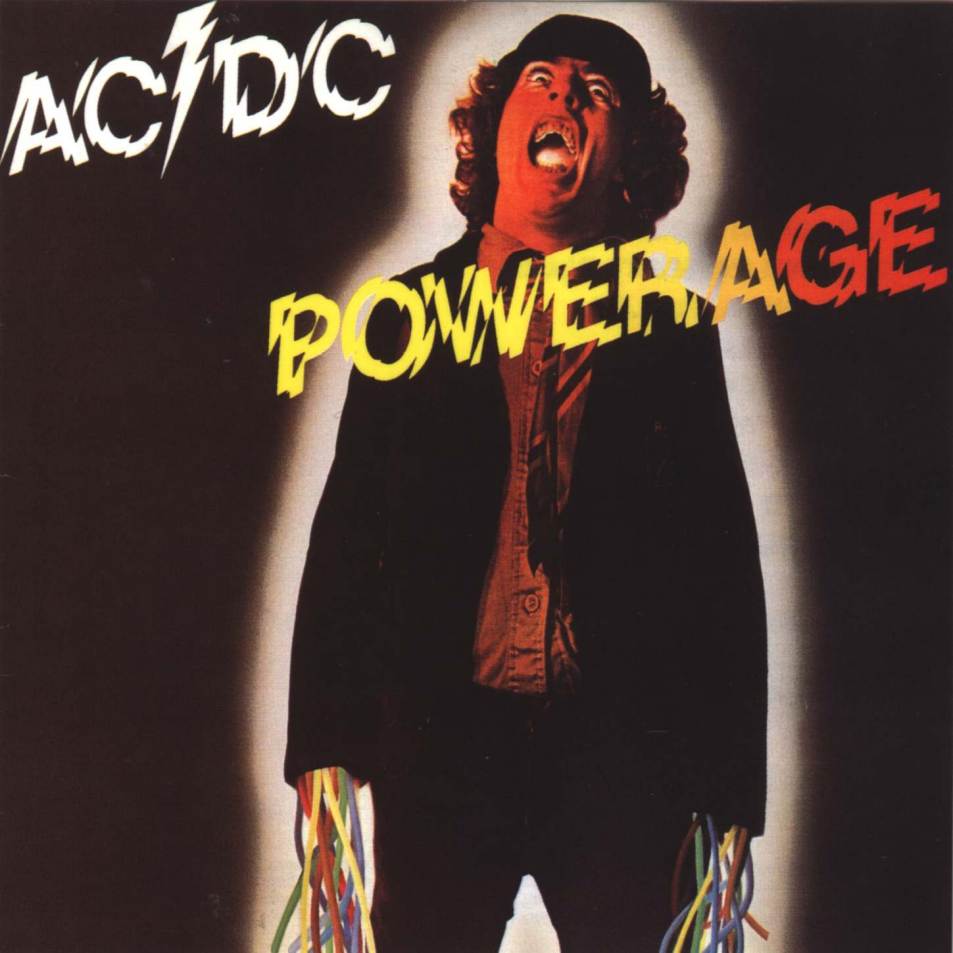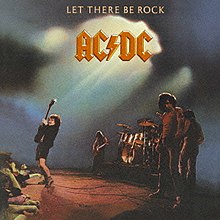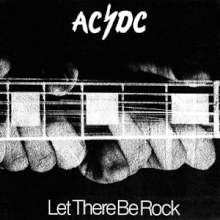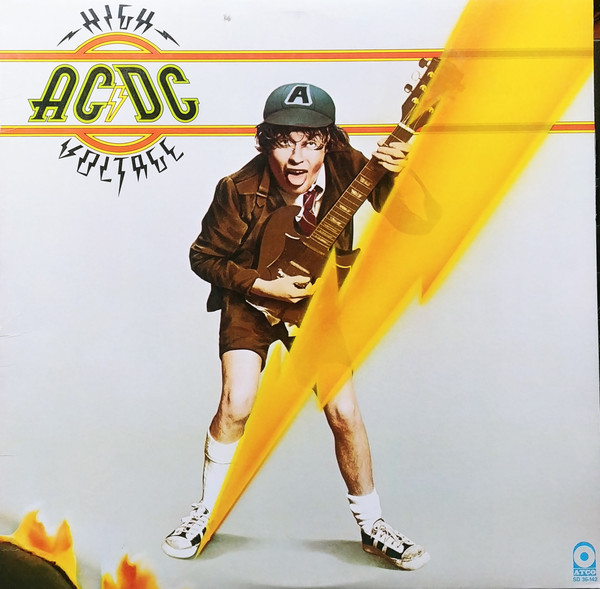
Rock and roll music

Let There Be Rock is the fourth studio album by Australian rock band AC/DC. It was originally released on 21 March 1977 in Australasia, through Albert Productions label. A modified international edition was released on 25 July 1977, through Atlantic Records. It was the last AC/DC album to feature Mark Evans on bass.
Background
Leer másLet There Be Rock
AC-DC
Label: Albert (Australia) Atlantic (UK & Europe) ATCO (US) · Studios: Albert (Sydney) · Productor: Harry Vanda , George Young
|
1
|
Go Down
AC-DC •
w: Angus Young, Malcolm Young and Bon Scott •
1977 /03 /21
|
5:31 |
|
|
|
2
|
Dog Eat Dog
AC-DC •
w: Angus Young, Malcolm Young and Bon Scott •
1977 /03 /21
|
3:35 |
|
|
|
3
|
Let There Be Rock
AC-DC •
w: Angus Young, Malcolm Young and Bon Scott •
1977 /03 /21
|
6:07 |
|
|
|
4
|
Bad Boy Boogie
AC-DC •
w: Angus Young, Malcolm Young and Bon Scott •
1977 /03 /21
|
4:28 |
|
|
|
5
|
Overdose
AC-DC •
w: Angus Young, Malcolm Young and Bon Scott •
1977 /03 /21
|
6:09 |
|
|
|
6
|
Crabsody In Blue
AC-DC •
w: Angus Young, Malcolm Young and Bon Scott •
1977 /03 /21
|
4:41 |
|
|
|
7
|
Hell Ain't A Bad Place To Be
AC-DC •
w: Angus Young, Malcolm Young and Bon Scott •
1977 /03 /21
|
4:14 |
|
|
|
8
|
Whole Lotta Rosie
AC-DC •
w: Angus Young, Malcolm Young and Bon Scott •
1977 /03 /21
|
5:23 |
|
Singles
No singles available
| Let There Be Rock | ||||
|---|---|---|---|---|
 International cover | ||||
| Studio album by | ||||
| Released | 21 March 1977[a] | |||
| Recorded | ||||
| Studio | Albert (Sydney) | |||
| Genre | ||||
| Length | 40:19 (Australia) 41:01 (international) | |||
| Label | ||||
| Producer | ||||
| AC/DC chronology | ||||
| ||||
| Alternative cover art | ||||
 Original Australian cover | ||||
| Singles from Let There Be Rock | ||||
| ||||
Review
Let There Be Rock is the fourth studio album by Australian rock band AC/DC. It was originally released on 21 March 1977 in Australasia, through Albert Productions label. A modified international edition was released on 25 July 1977, through Atlantic Records. It was the last AC/DC album to feature Mark Evans on bass.
Background
Leer másIn late 1976 AC/DC were in a slump. "It was very close to being all over", manager Michael Browning said. "Things were progressing very well in London and Europe. We`d been through a whole thing with the Marquee where they broke all the house records. We`d done the `Lock Up Your Daughters` UK tour and the Reading Festival. It was all shaping up really well."
[3] "In the middle of the tour, I get a phone call saying Atlantic Records in America didn`t like the Dirty Deeds album", said Browning. "That, in fact, they were going to drop the group from the label. And that`s when things got really bad."
"There was always a siege mentality about that band. But once we all found out that Atlantic had knocked us back the attitude was: `Fuck them! Who the fuck do they think they are?` So from that point onwards it was: `Fuck, we`ll show them!` We were seriously fucking pissed off about it. It didn`t need to be discussed. We were going to go in and make that album and shove it up their arse!"
— Mark Evans
Angus Young said, "Our brother George asked us what kind of album we wanted to make and we said it would be great if we could just make a lot of guitar riffs, because we were all fired up after doing all this touring."[4]
Artwork
The Australian cover features the fingers of guitarist Chris Turner, from Australian band Buffalo. "There was a bloke called Colin Stead, who was in Buffalo for about ten minutes," Turner recalled. "He was also the centrefold photographer for Playboy. He phoned me up and said he was doing the album cover for Let There Be Rock, but AC/DC were out of town, so could I help out? He wanted a flash guitar run up and down the neck. Apparently, when he saw it, Angus said, `He`s got fat fingers, hasn`t he?`"[5]
The cover of the international version, released in July 1977, marked the first appearance of the band`s now iconic logo, designed by Gerard Huerta. The photograph used for the international cover was taken at a concert on 19 March 1977 at the Kursaal Ballroom, Southend, Essex, UK, by rock photographer Keith Morris.[6]
Reception
| Review scores | |
|---|---|
| Source | Rating |
| AllMusic | [7] |
| Classic Rock | [8] |
| The Encyclopedia of Popular Music | [9] |
| MusicHound Rock | [10] |
| The Quietus | (favourable)[11] |
| The Rolling Stone Album Guide | [12] |
| Spin Alternative Record Guide | 5/10[13] |
Reception to Let There Be Rock was extremely positive; according to AllMusic, which gave the album a rating of four and a half out of five stars in a retrospective review, AC/DC played "sweaty, dirty, nasty rock" and the band had "rarely done that kind of rock better than they did" on Let There Be Rock.[7]
In 2001, Q magazine named Let There Be Rock as one of the 50 Heaviest Albums of All Time.[14]
Cashbox said "Heavy metal is their special forte and there is plenty of voltage displayed on this electrified disc."[15]
Eduardo Rivadavia of AllMusic enthuses, "Let There Be Rock sees AC/DC`s religious-like respect for the simple art of making rock & roll brought to its logical conclusion: a veritable gospel to the glory of rock, canonized here in hymn-like worship. The near-epic title track to what is widely regarded as the best Bon Scott-era album, the song is a holy testimony, bringing good news to all those who believe in the healing power of rock & roll -- amen! Oh yeah, it also kicks unholy ass!"[16]
David Fricke of Rolling Stone wrote of the album in a 2008 cover story, "AC/DC`s early albums were perfectly frenetic, but inconsistent. Their second U.S. LP was almost all killer. Scott sings `Bad Boy Boogie` and `Problem Child` like he`s the enfant terrible...Angus` solos are true white heat." In 2006, AC/DC biographer Murray Engleheart wrote that Let There Be Rock "elevated AC/DC to the status of an album band, something that had previously been the exclusive domain of the likes of The Rolling Stones, The Who and Led Zeppelin." In 2000, Angus Young recalled to Guitar World that producer Mutt Lange once told him "of all the many albums we`d done with my brother George and his partner, Harry Vanda, the one Mutt wished he would have done, where he was envious of George, was Let There Be Rock." Band biographer Jesse Fink writes, "Wherever AC/DC ended up in the annals of rock history, this album would stand for all time as an expression of their unrivaled might as a guitar band."[17]
Track listing
Australian version
All tracks are written by Angus Young, Malcolm Young and Bon Scott
| No. | Title | Length |
|---|---|---|
| 1. | "Go Down" | 5:17 |
| 2. | "Dog Eat Dog" | 3:35 |
| 3. | "Let There Be Rock" | 6:06 |
| 4. | "Bad Boy Boogie" | 4:27 |
| No. | Title | Length |
|---|---|---|
| 5. | "Overdose" | 6:09 |
| 6. | "Crabsody in Blue" | 4:44 |
| 7. | "Hell Ain`t a Bad Place to Be" | 4:14 |
| 8. | "Whole Lotta Rosie" | 5:24 |
| Total length: | 40:19 | |
International version
| No. | Title | Length |
|---|---|---|
| 1. | "Go Down" | 5:31 |
| 2. | "Dog Eat Dog" | 3:35 |
| 3. | "Let There Be Rock" | 6:06 |
| 4. | "Bad Boy Boogie" | 4:27 |
| No. | Title | Length |
|---|---|---|
| 5. | "Problem Child" | 5:25 |
| 6. | "Overdose" | 6:09 |
| 7. | "Hell Ain`t a Bad Place to Be" | 4:14 |
| 8. | "Whole Lotta Rosie" | 5:24 |
| Total length: | 41:01 | |
Notes
- For the original Australian vinyl release a different version of "Go Down" was used. This version has an early fade-out, changing the length of the song to only 5:17.
- Track 5, "Problem Child", was originally released on Dirty Deeds Done Dirt Cheap in 1976. This is a shortened version of the original, missing the reprise coda.
- For the original vinyl release, in all markets other than the US, Canada and Japan, "Crabsody in Blue" was featured instead of "Problem Child".
Personnel
AC/DC
- Bon Scott – lead vocals
- Angus Young – lead guitar
- Malcolm Young – rhythm guitar, backing vocals
- Mark Evans – bass guitar
- Phil Rudd – drums, percussion
Production
- Harry Vanda – producer
- George Young – producer
- Mark Opitz – engineer
- Michael Fraser – mastering supervisor
- Al Quaglieri – mastering supervisor
- George Marino – mastering
- Eugene Nastasi – digital assembly
- Bob Defrin – art direction
- Richard Ford – artwork
- Gerard Huerta – cover lettering
- Murray Engleheart – liner notes
Charts
| Chart (1977–1981) | Peak position |
|---|---|
| Australian Albums (Kent Music Report)[18] | 19 |
| Dutch Albums (Album Top 100)[19] | 10 |
| New Zealand Albums (RMNZ)[20] | 42 |
| Swedish Albums (Sverigetopplistan)[21] | 29 |
| UK Albums (OCC)[22] | 17 |
| US Billboard 200[23] | 154 |
| Chart (2003) | Peak position |
|---|---|
| Norwegian Albums (VG-lista)[24] | 37 |
| Chart (2024) | Peak position |
|---|---|
| German Albums (Offizielle Top 100)[25] | 40 |
| Swiss Albums (Schweizer Hitparade)[26] | 17 |
Certifications
| Region | Certification | Certified units/sales |
|---|---|---|
| Australia (ARIA)[27] | 5× Platinum | 350,000^ |
| France (SNEP)[28] | Gold | 100,000* |
| Germany (BVMI)[29] | Platinum | 500,000^ |
| Spain (PROMUSICAE)[30] | Gold | 50,000^ |
| United Kingdom (BPI)[31] | Gold | 100,000^ |
| United States (RIAA)[32] | 2× Platinum | 2,000,000^ |
* Sales figures based on certification alone. | ||
Let There Be Rock is the fourth studio album by Australian rock band AC/DC. It was originally released on 21 March 1977 in Australasia, through Albert Productions label. A modified international edition was released on 25 July 1977, through Atlantic Records. It was the last AC/DC album to feature Mark Evans on bass.
Background
In late 1976 AC/DC were in a slump. "It was very close to being all over", manager Michael Browning said. "Things were progressing very well in London and Europe. We`d been through a whole thing with the Marquee where they broke all the house records. We`d done the `Lock Up Your Daughters` UK tour and the Reading Festival. It was all shaping up really well."
[3] "In the middle of the tour, I get a phone call saying Atlantic Records in America didn`t like the Dirty Deeds album", said Browning. "That, in fact, they were going to drop the group from the label. And that`s when things got really bad."
"There was always a siege mentality about that band. But once we all found out that Atlantic had knocked us back the attitude was: `Fuck them! Who the fuck do they think they are?` So from that point onwards it was: `Fuck, we`ll show them!` We were seriously fucking pissed off about it. It didn`t need to be discussed. We were going to go in and make that album and shove it up their arse!"
— Mark Evans
Angus Young said, "Our brother George asked us what kind of album we wanted to make and we said it would be great if we could just make a lot of guitar riffs, because we were all fired up after doing all this touring."[4]
Artwork
The Australian cover features the fingers of guitarist Chris Turner, from Australian band Buffalo. "There was a bloke called Colin Stead, who was in Buffalo for about ten minutes," Turner recalled. "He was also the centrefold photographer for Playboy. He phoned me up and said he was doing the album cover for Let There Be Rock, but AC/DC were out of town, so could I help out? He wanted a flash guitar run up and down the neck. Apparently, when he saw it, Angus said, `He`s got fat fingers, hasn`t he?`"[5]
The cover of the international version, released in July 1977, marked the first appearance of the band`s now iconic logo, designed by Gerard Huerta. The photograph used for the international cover was taken at a concert on 19 March 1977 at the Kursaal Ballroom, Southend, Essex, UK, by rock photographer Keith Morris.[6]
Reception
| Review scores | |
|---|---|
| Source | Rating |
| AllMusic | [7] |
| Classic Rock | [8] |
| The Encyclopedia of Popular Music | [9] |
| MusicHound Rock | [10] |
| The Quietus | (favourable)[11] |
| The Rolling Stone Album Guide | [12] |
| Spin Alternative Record Guide | 5/10[13] |
Reception to Let There Be Rock was extremely positive; according to AllMusic, which gave the album a rating of four and a half out of five stars in a retrospective review, AC/DC played "sweaty, dirty, nasty rock" and the band had "rarely done that kind of rock better than they did" on Let There Be Rock.[7]
In 2001, Q magazine named Let There Be Rock as one of the 50 Heaviest Albums of All Time.[14]
Cashbox said "Heavy metal is their special forte and there is plenty of voltage displayed on this electrified disc."[15]
Eduardo Rivadavia of AllMusic enthuses, "Let There Be Rock sees AC/DC`s religious-like respect for the simple art of making rock & roll brought to its logical conclusion: a veritable gospel to the glory of rock, canonized here in hymn-like worship. The near-epic title track to what is widely regarded as the best Bon Scott-era album, the song is a holy testimony, bringing good news to all those who believe in the healing power of rock & roll -- amen! Oh yeah, it also kicks unholy ass!"[16]
David Fricke of Rolling Stone wrote of the album in a 2008 cover story, "AC/DC`s early albums were perfectly frenetic, but inconsistent. Their second U.S. LP was almost all killer. Scott sings `Bad Boy Boogie` and `Problem Child` like he`s the enfant terrible...Angus` solos are true white heat." In 2006, AC/DC biographer Murray Engleheart wrote that Let There Be Rock "elevated AC/DC to the status of an album band, something that had previously been the exclusive domain of the likes of The Rolling Stones, The Who and Led Zeppelin." In 2000, Angus Young recalled to Guitar World that producer Mutt Lange once told him "of all the many albums we`d done with my brother George and his partner, Harry Vanda, the one Mutt wished he would have done, where he was envious of George, was Let There Be Rock." Band biographer Jesse Fink writes, "Wherever AC/DC ended up in the annals of rock history, this album would stand for all time as an expression of their unrivaled might as a guitar band."[17]
Track listing
Australian version
All tracks are written by Angus Young, Malcolm Young and Bon Scott
| No. | Title | Length |
|---|---|---|
| 1. | "Go Down" | 5:17 |
| 2. | "Dog Eat Dog" | 3:35 |
| 3. | "Let There Be Rock" | 6:06 |
| 4. | "Bad Boy Boogie" | 4:27 |
| No. | Title | Length |
|---|---|---|
| 5. | "Overdose" | 6:09 |
| 6. | "Crabsody in Blue" | 4:44 |
| 7. | "Hell Ain`t a Bad Place to Be" | 4:14 |
| 8. | "Whole Lotta Rosie" | 5:24 |
| Total length: | 40:19 | |
International version
| No. | Title | Length |
|---|---|---|
| 1. | "Go Down" | 5:31 |
| 2. | "Dog Eat Dog" | 3:35 |
| 3. | "Let There Be Rock" | 6:06 |
| 4. | "Bad Boy Boogie" | 4:27 |
| No. | Title | Length |
|---|---|---|
| 5. | "Problem Child" | 5:25 |
| 6. | "Overdose" | 6:09 |
| 7. | "Hell Ain`t a Bad Place to Be" | 4:14 |
| 8. | "Whole Lotta Rosie" | 5:24 |
| Total length: | 41:01 | |
Notes
- For the original Australian vinyl release a different version of "Go Down" was used. This version has an early fade-out, changing the length of the song to only 5:17.
- Track 5, "Problem Child", was originally released on Dirty Deeds Done Dirt Cheap in 1976. This is a shortened version of the original, missing the reprise coda.
- For the original vinyl release, in all markets other than the US, Canada and Japan, "Crabsody in Blue" was featured instead of "Problem Child".
Personnel
AC/DC
- Bon Scott – lead vocals
- Angus Young – lead guitar
- Malcolm Young – rhythm guitar, backing vocals
- Mark Evans – bass guitar
- Phil Rudd – drums, percussion
Production
- Harry Vanda – producer
- George Young – producer
- Mark Opitz – engineer
- Michael Fraser – mastering supervisor
- Al Quaglieri – mastering supervisor
- George Marino – mastering
- Eugene Nastasi – digital assembly
- Bob Defrin – art direction
- Richard Ford – artwork
- Gerard Huerta – cover lettering
- Murray Engleheart – liner notes
Charts
| Chart (1977–1981) | Peak position |
|---|---|
| Australian Albums (Kent Music Report)[18] | 19 |
| Dutch Albums (Album Top 100)[19] | 10 |
| New Zealand Albums (RMNZ)[20] | 42 |
| Swedish Albums (Sverigetopplistan)[21] | 29 |
| UK Albums (OCC)[22] | 17 |
| US Billboard 200[23] | 154 |
| Chart (2003) | Peak position |
|---|---|
| Norwegian Albums (VG-lista)[24] | 37 |
| Chart (2024) | Peak position |
|---|---|
| German Albums (Offizielle Top 100)[25] | 40 |
| Swiss Albums (Schweizer Hitparade)[26] | 17 |
Certifications
| Region | Certification | Certified units/sales |
|---|---|---|
| Australia (ARIA)[27] | 5× Platinum | 350,000^ |
| France (SNEP)[28] | Gold | 100,000* |
| Germany (BVMI)[29] | Platinum | 500,000^ |
| Spain (PROMUSICAE)[30] | Gold | 50,000^ |
| United Kingdom (BPI)[31] | Gold | 100,000^ |
| United States (RIAA)[32] | 2× Platinum | 2,000,000^ |
* Sales figures based on certification alone. | ||
More Albums same artist
Go Down · Channel: AC/DC - Topic · 5m 32s


Dog Eat Dog · Channel: AC/DC - Topic · 3m 35s

AC/DC - Let There Be Rock (Official Video) · Channel: acdcVEVO · 6m 9s

AC/DC - Bad Boy Boogie (BBC Rock Goes to College, 1978) · Channel: acdcVEVO · 8m 58s

Overdose · Channel: AC/DC - Topic · 6m 10s

Crabsody In Blue · Channel: AC/DC - Topic · 4m 44s

Hell Ain't a Bad Place to Be · Channel: AC/DC - Topic · 4m 15s





